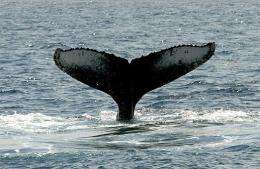Whale sonar: Two pings are better than one

Many whale species have sonar systems that send out two pings at once, allowing them to detect underwater objects with greater accuracy than even the most sophisticated human technologies, according to a study released Wednesday.
It has long been known that whales use echolocation -- emitting sounds that bounce back after hitting objects -- to find food and navigate.
But scientists have never been able to demonstrate exactly which parts of the whale anatomy produce the distinctive clicking sound that probes the depths, nor why these internal sonar systems are so precise.
In a unique experiment, a pair of marine biologists designed an underwater echo chamber at the Oceanografic Aquarium in Valencia, Spain.
A captive nine-year-old beluga whale was trained to position herself in a steel hoop one meter (3.25 feet) below the surface of the water and to echolocate on command.
The sounds she emitted were picked up with two underwater microphones, one directly in front of the whale and another to its side.
Computer analysis of the recordings revealed "two distinct pulses" of sound that were so close together as to be indistinguishable to the human ear.
After eliminating all other possible sources for the double ping -- such as reflective surfaces off of which the sounds might have bounced -- the researchers concluded the pulses could only have come from the animal itself.
Using an endoscope lowered through the whale's blowhole into the upper nasal region, they were also able to confirm that the sounds are produced by structures called "phonic lips" that can produce clicks simultaneously or independently.
It was the first time that the process had been directly observed during echolocation, according to the study, published in the British journal Biology Letters.
Marc Lammers of the University of Hawaii and Manuel Castellote of Oceanografic speculate that the double sonar system holds several advantages for the beluga.
One is greater carrying power: the summed energy of two pulses significantly expands the range across which the whale can detect objects.
The fact that the each set of phonic lips produces different frequencies also results in a broader spectrum of sound, providing "advantages for target detection and classification," the study says.
"An intriguing possibility is that the beluga may use slight time delays in the production of each pulse to actively control the width and orientation of its echolocation beam," the researchers note.
It is likely, they conclude, that the ability to produce double pulses is shared by other whales in the same sub-order known as odontocete cetaceans -- whales with teeth -- such as killer, pilot and sperm whales.
Dolphins may also have the same capacity, they said.
(c) 2009 AFP





















